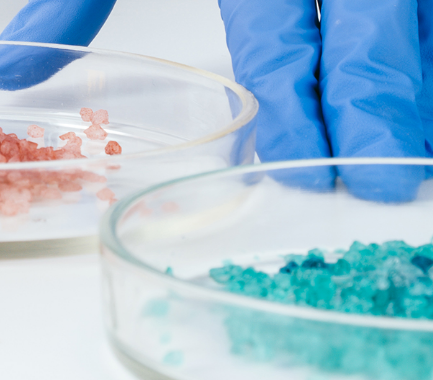Your contact
PENPET-Team - Hamburg

Tim Meister
Sales
Tel. +49 (0) 40 - 675 7 99 40
sales@penpet.de
Get in touch with us.
Ethyl acrylate (EA)
Ethyl acrylate (EA) is an organic compound that belongs to the carboxylic acid esters and is an important starting material for polymerization reactions. The substance can be obtained using various synthesis processes. The direct esterification of ethanol and acrylic acid is of industrial importance. In addition, production processes from acrylonitrile, sulfuric acid and ethanol as well as from acetylene, ethanol and carbon monoxide are used. Natural occurrences of small amounts of ethyl acrylate include in passion fruit and pineapple.
The compound is used in the production of polymeric materials together with other comonomers such as methacrylates, vinyl acetate, acrylonitrile, styrene, vinyl chloride and maleic acid esters. In this way, ethyl acrylate is used in the manufacture of synthetic resins, plastics, rubber, adhesives, lacquers, paints, coatings, pharmaceutical products, cosmetics and detergents, as well as in the processing of paper, textiles and leather. In addition, the substance is used in the chemical industry as an intermediate product for the synthetic production of numerous organic compounds.
At PENPET you get ethyl acrylate (EA) of the highest quality - from a reliable partner who will also meet your requirements in the long term. We look forward to receiving your inquiry for an individual offer. Prompt delivery of the liquid compound can be made in packages with different weights.
CAS no. 140-88-5
EINECS no. 205-438-8
Molecular formula: C5H8O2
Synonyms: EA, Ethyl Acrylate, Ethyl Acrylate, Ethyl Propenate, Ethyl Propenoate
Areas of application: Starting material for the production of polymeric compounds, raw material for the production of adhesives, paints, varnishes, coatings, plastics, rubber, synthetic resins, cosmetics, cleaning agents and pharmaceutical products, intermediate product for synthesis in organic chemistry
More Information
As a carboxylic acid ester, ethyl acrylate (EA) is made up of two organic components. The compound consists of the remainder of the acrylic acid plus an ethyl group. The hydroxy and carboxyl groups of the starting materials were converted into a common ester group. In addition to this functional group, the substance with the resulting double bond between the terminal carbon atoms of the acrylic acid has a second reactive site. Ethyl acrylate can therefore undergo numerous reactions. Among other things, the substance tends to spontaneously polymerize and can be used together with other comonomers to produce polymer materials.
Under normal conditions, ethyl acrylate (EA) is a colorless, highly volatile liquid that boils at a temperature of 100 °C and reaches its melting point when it cools to -75 °C. The compound has a pungent but fruity inherent odor. Ethyl acrylate is only poorly soluble in water. In contrast, the substance is highly soluble in many organic solvents such as diethyl ether, ethanol and chloroform.
Ethyl acrylate (EA) is a chemically very unstable compound. Under the influence of heat, light or peroxides, the substance tends to undergo uncontrolled polymerization, which can cause closed containers to burst. A stabilizer is added to the substance to prevent this spontaneous reaction. Contact with strong oxidizing agents can also lead to dangerous, violent reactions. Ethyl acrylate should therefore be stored in a cool, dark and airtight place.
Ethyl acrylate is combustible and highly flammable. The vapors of the volatile compound can also combine with the ambient air to form explosive air-vapor mixtures. Due to their density, these gather on the floor and can spread unnoticed in the work rooms. To avoid dangerous remote ignition, when handling open containers of the substance, care must be taken to ensure that there is sufficient distance to potential sources of ignition such as sparks, electrical discharges, hot surfaces and flames. When burning and thermally decomposing ethyl acrylate, acrid and harmful substances are released. In particular, large amounts of dangerous gases such as carbon dioxide and carbon monoxide can be produced.
Ethyl Acrylate (EA) is an irritant hazardous material. If the liquid comes into contact with the skin, irritation, redness, swelling and chemical burns may occur. Persistent sensitizations are possible. Soaked parts of the body should be rinsed with soap and water and examined by a doctor. In the eye, the compound can cause irritation and swelling of the conjunctiva and temporary clouding of the cornea. The affected eye should be rinsed under running water and immediately treated by an ophthalmologist.
Inhalation of ethyl acrylate vapors or aerosols will cause severe respiratory irritation. Swelling and lung damage can also occur. If the compound is swallowed, painful irritation of the mucous membranes and gastrointestinal symptoms such as nausea, vomiting and diarrhea are to be expected. If ethyl acrylate is absorbed into the metabolism, headaches, drowsiness, cramps, cardiovascular problems, disorders of the central nervous system and functional disorders of the liver and kidneys can occur. If poisoning is suspected, seek medical treatment immediately. There is a risk of cancer with long-term exposure to the substance.
Ethyl acrylate has been classified as clearly hazardous to water due to its harmful effects on aquatic organisms. The compound must not enter water bodies, the ground or waste water. In the event of a large spillage of the substance, the local authorities should be informed. As a hazardous substance, ethyl acrylate is subject to special transport regulations.
